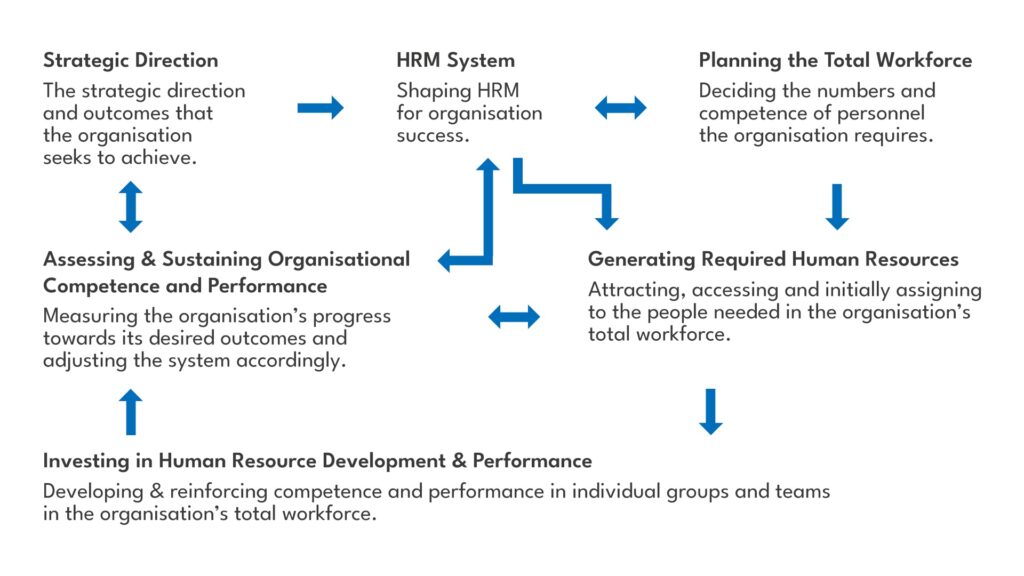Human Resources (HR) has evolved from merely an operational element to a strategic asset that determines a company’s success. According to a study by the World Economic Forum, more than 50% of the value of global companies now comes from intangible assets, including employee skills and knowledge. In this context, strategic HR management becomes a key driver in creating sustainable competitive advantage.
Beyond administrative management, effective HR helps organizations achieve business goals by optimizing their workforce. A report by Harvard Business Review reveals that companies consistently integrating HR strategies with business objectives experience 23% higher revenue growth compared to those that don’t.
To delve deeper into this subject, we’ll explore key concepts in HR management, highlight a case study from Cisco Systems Inc., and identify critical elements of a successful HR strategy.
Why Human Resource Management Is Key to Business Success

In today’s world, HR is more than just an asset; it’s the driving force behind innovation and growth. According to research in Contemporary Human Resource Management, companies with robust HR strategies see productivity increases of up to 23%. This data underscores that well-managed HR can provide a strategic edge in competitive markets.
Furthermore, HR plays a crucial role in aligning individual goals with organizational vision. This means HR is not just about enhancing individual performance but ensuring those contributions support the company’s broader strategy. Thus, effective HR management bridges the gap between employee potential and organizational objectives.
The Strategic Framework for HR Management

According to the HR Strategic Planning Principles, successful HR management relies on a well-structured framework. Here’s how its key elements interconnect:
1. Defining the Organization’s Strategic Direction
Every effective HR strategy begins with a deep understanding of the organization’s strategic direction. This involves identifying its vision, mission, and long-term goals, such as market expansion, product innovation, or customer experience enhancement. HR acts as a key driver, ensuring every employee activity aligns with these objectives.
Steps to Consider:
- Conduct an external environmental analysis to identify opportunities and challenges.
- Define the organization’s vision, mission, and core values.
- Set clear strategic goals.
- Engage key stakeholders in the planning process.
- Assess regulatory and compliance impacts on business operations.
2. Designing HR Management Systems
At this stage, companies must align HR policies and practices with strategic needs. This includes adopting industry best practices or tailoring them to the organization’s unique characteristics.
For example, some companies implement flexible work policies or leverage digital technology to boost productivity. However, every change should be preceded by a cost-benefit analysis to ensure its value aligns with organizational goals.
Steps to Consider:
- Identify HR policies and practices relevant to organizational goals.
- Analyze and adopt industry best practices.
- Review employment systems for compliance and effectiveness.
3. Workforce Planning
Planning for future workforce needs is one of HR’s biggest challenges. Workforce planning involves ensuring the company has the right number and type of employees, with the necessary competencies, at the right time.
Steps to Consider:
- Design an organizational structure that supports strategic goals.
- Develop job descriptions based on key competencies and activities.
- Create a workforce plan that aligns with business targets.
- Map current workforce capabilities and identify future needs.
4. Recruiting and Developing Talent
This step focuses on hiring, training, and managing employees in line with organizational needs. Tailored training programs ensure employees possess relevant skills for both current and future demands.
Steps to Consider:
- Evaluate recruitment and selection processes for alignment with strategic objectives.
- Develop training programs based on organizational needs.
- Implement learning strategies to support employee growth.
- Define clear job classifications and categories.
5. Investing in Employee Development and Performance
Modern HR strategies emphasize career development, performance evaluation, and reward systems aligned with organizational goals. Continuous training, recognition of prior skills, and merit-based promotions foster a culture of growth and excellence.
Steps to Consider:
- Design clear career paths for employees.
- Implement objective performance evaluation systems.
- Offer comprehensive employee development programs.
- Establish fair and competitive reward policies.
6. Measuring and Sustaining Organizational Competency
Many companies struggle to measure the impact of HR policies on performance. Clear metrics are essential to evaluate employee contributions to business outcomes and the effectiveness of HR policies.
Steps to Consider:
- Regularly assess organizational culture and climate.
- Develop succession plans for long-term leadership.
- Use quantitative metrics to evaluate HR strategy effectiveness.
- Revise and adapt HR strategies as organizational dynamics evolve.
Case Study: Cisco Systems Inc.’s Success in HR Management

Cisco Systems Inc. is a real-world example of a company that has successfully implemented data-driven HR strategies. As a major player in the tech industry, Cisco faces significant challenges in maintaining its competitive position. Here are some strategic steps Cisco has taken:
1. Structured Employee Development Programs
Cisco invests more than $300 million annually in training and development programs. These programs include technical training as well as soft skills such as leadership. Internal surveys show that 92% of employees are satisfied with the career development opportunities provided by the company.
2. Utilizing Technology in HR Management
Cisco leverages cloud-based technology to manage all HR processes, from recruitment to performance evaluations. This implementation has increased operational efficiency by 20%. Additionally, Cisco uses analytics to predict workforce needs and identify employees with the potential to fill strategic roles in the future.
3. Diversity and Inclusion as a Core Pillar
Diversity is one of Cisco’s primary focuses. The company has successfully increased minority participation in senior management positions by 40%. This not only creates an inclusive work environment but also enhances team innovation and performance.
4. Data-Driven Performance Management
Cisco applies a data-driven performance management system that allows real-time performance monitoring. Through this approach, Cisco can provide constructive feedback and set realistic targets. As a result, the company has recorded a 15% improvement in team performance over the past two years.
Key Success Factors in HR Management

Based on analyses from Contemporary Human Resource Management and HR Strategic Planning Principles, several key elements determine the success of HR management:
1. Strategic Alignment
HR management must align with the organization’s strategic objectives. Without this alignment, HR initiatives may fail to significantly impact business goal achievement.
2. Investment in Employee Development
Companies that invest in employee training and development can enhance their skills and productivity. Additionally, structured career development programs help retain top talent.
3. Technology Utilization
Technology plays a vital role in modern HR management. From automating recruitment processes to performance data analysis, technology enables companies to make faster and better decisions.
4. Performance-Based Compensation and Rewards
Fair and transparent compensation systems boost employee motivation and retention. Rewards for specific achievements can also encourage employees to meet higher targets.
Discover More: Tips to Avoid Operating Loss (OL) in Business
Benefits of Effective HR Management

Good HR management provides various strategic benefits for companies, ranging from increased productivity to competitive advantages. Here are the main benefits companies can experience:
1. Increased Productivity
According to data from HR Strategic Planning Principles, companies that apply data-driven HR strategies record productivity increases of up to 25%. Effective performance management enables companies to:
- Identify productivity barriers.
- Improve efficiency through targeted training.
- Reward high-performing employees, ultimately boosting motivation.
2. Higher Employee Retention
One of the main challenges in HR is retaining top talent. With career development programs and performance-based compensation, companies can reduce turnover rates by up to 15%. Employees who feel valued and supported are more likely to remain loyal to the company.
3. Competitive Advantage
In competitive markets, companies with strong HR strategies can adapt more quickly to changes. For example, Cisco was able to rapidly shift its focus to digital innovation, thanks to its technology-based training system.
4. Operational Efficiency
Good HR management helps companies optimally allocate resources. Through data analysis, companies can identify areas that need improvement and streamline business processes to reduce waste.
5. Increased Profitability
Operational efficiency and improved productivity directly impact profit margins. Data shows that companies with effective HR systems report a net profit increase of up to 20% compared to companies with less optimal HR management.
6. Strong Corporate Culture
A positive corporate culture not only boosts employee morale but also enhances the company’s reputation. Companies known for their good work culture find it easier to attract high-quality talent.
7. Adaptability to Change
The business environment is constantly changing, and companies with strong HR systems are better prepared to navigate these changes. This includes adopting new technologies, responding to market trends, and meeting evolving employee expectations.
HR management is not merely a support function but a strategic element that determines a company’s success. By implementing data-driven strategies, leveraging technology, and strong leadership, companies can create a productive and competitive work environment.
If you are looking for a partner to help design and implement optimal HR strategies, Arghajata Consulting is here to assist. With a data-driven approach and deep experience, we are ready to help your company achieve sustainable growth. Contact us here for further consultation.

















